Uber in Global Markets: Cultural Values and Regulatory Impacts
VerifiedAdded on 2023/06/17
|13
|3580
|224
Essay
AI Summary
This essay provides an in-depth analysis of Uber's global business environment, focusing on the cultural and regulatory challenges the company faces in its international expansion. It examines the differences in cultural values between the United States and China, utilizing Hofstede's six dimensions to highlight these disparities. The essay also discusses how these cultural differences, along with varying regulatory and institutional frameworks, have contributed to the company's successes and failures in different markets. Furthermore, it explores the elements of culture, including communication, values, language, religion, and attitudes, and their impact on international business operations. The report concludes by emphasizing the importance of understanding these factors for companies like Uber to effectively navigate the complexities of the global marketplace. Desklib provides access to similar past papers and solved assignments for students.

Paraphrase This Document
Need a fresh take? Get an instant paraphrase of this document with our AI Paraphraser
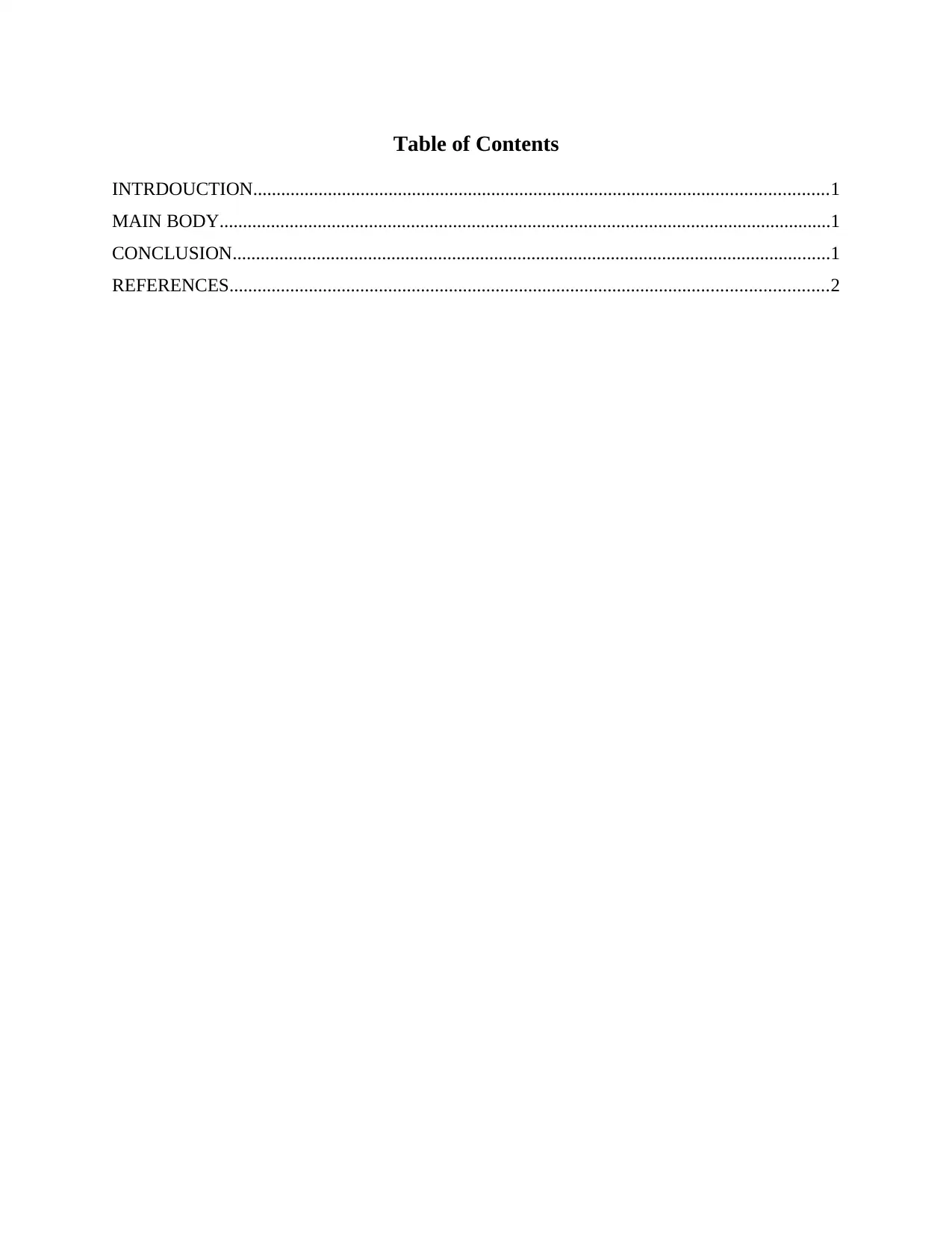
Table of Contents
INTRDOUCTION...........................................................................................................................1
MAIN BODY...................................................................................................................................1
CONCLUSION................................................................................................................................1
REFERENCES................................................................................................................................2
INTRDOUCTION...........................................................................................................................1
MAIN BODY...................................................................................................................................1
CONCLUSION................................................................................................................................1
REFERENCES................................................................................................................................2
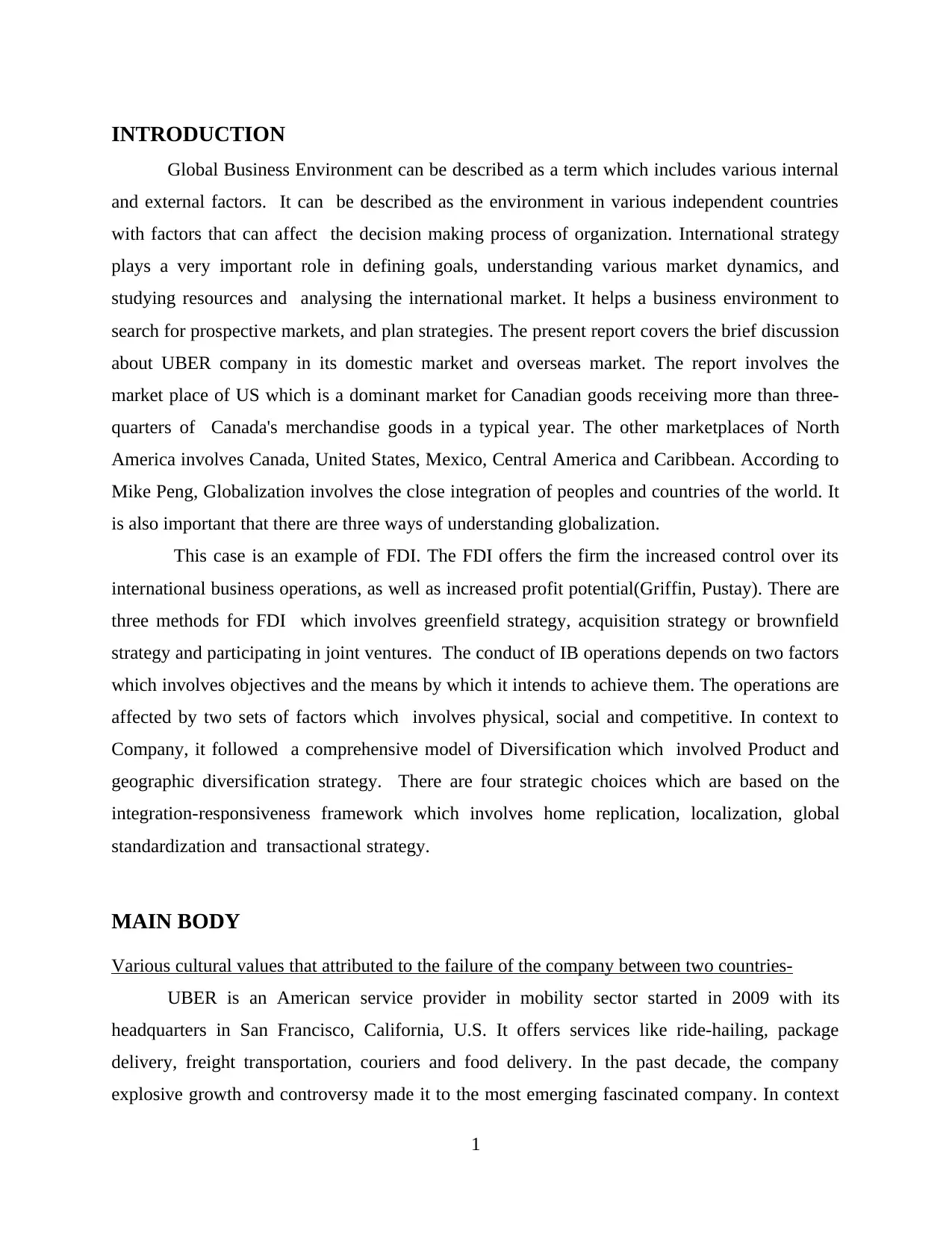
INTRODUCTION
Global Business Environment can be described as a term which includes various internal
and external factors. It can be described as the environment in various independent countries
with factors that can affect the decision making process of organization. International strategy
plays a very important role in defining goals, understanding various market dynamics, and
studying resources and analysing the international market. It helps a business environment to
search for prospective markets, and plan strategies. The present report covers the brief discussion
about UBER company in its domestic market and overseas market. The report involves the
market place of US which is a dominant market for Canadian goods receiving more than three-
quarters of Canada's merchandise goods in a typical year. The other marketplaces of North
America involves Canada, United States, Mexico, Central America and Caribbean. According to
Mike Peng, Globalization involves the close integration of peoples and countries of the world. It
is also important that there are three ways of understanding globalization.
This case is an example of FDI. The FDI offers the firm the increased control over its
international business operations, as well as increased profit potential(Griffin, Pustay). There are
three methods for FDI which involves greenfield strategy, acquisition strategy or brownfield
strategy and participating in joint ventures. The conduct of IB operations depends on two factors
which involves objectives and the means by which it intends to achieve them. The operations are
affected by two sets of factors which involves physical, social and competitive. In context to
Company, it followed a comprehensive model of Diversification which involved Product and
geographic diversification strategy. There are four strategic choices which are based on the
integration-responsiveness framework which involves home replication, localization, global
standardization and transactional strategy.
MAIN BODY
Various cultural values that attributed to the failure of the company between two countries-
UBER is an American service provider in mobility sector started in 2009 with its
headquarters in San Francisco, California, U.S. It offers services like ride-hailing, package
delivery, freight transportation, couriers and food delivery. In the past decade, the company
explosive growth and controversy made it to the most emerging fascinated company. In context
1
Global Business Environment can be described as a term which includes various internal
and external factors. It can be described as the environment in various independent countries
with factors that can affect the decision making process of organization. International strategy
plays a very important role in defining goals, understanding various market dynamics, and
studying resources and analysing the international market. It helps a business environment to
search for prospective markets, and plan strategies. The present report covers the brief discussion
about UBER company in its domestic market and overseas market. The report involves the
market place of US which is a dominant market for Canadian goods receiving more than three-
quarters of Canada's merchandise goods in a typical year. The other marketplaces of North
America involves Canada, United States, Mexico, Central America and Caribbean. According to
Mike Peng, Globalization involves the close integration of peoples and countries of the world. It
is also important that there are three ways of understanding globalization.
This case is an example of FDI. The FDI offers the firm the increased control over its
international business operations, as well as increased profit potential(Griffin, Pustay). There are
three methods for FDI which involves greenfield strategy, acquisition strategy or brownfield
strategy and participating in joint ventures. The conduct of IB operations depends on two factors
which involves objectives and the means by which it intends to achieve them. The operations are
affected by two sets of factors which involves physical, social and competitive. In context to
Company, it followed a comprehensive model of Diversification which involved Product and
geographic diversification strategy. There are four strategic choices which are based on the
integration-responsiveness framework which involves home replication, localization, global
standardization and transactional strategy.
MAIN BODY
Various cultural values that attributed to the failure of the company between two countries-
UBER is an American service provider in mobility sector started in 2009 with its
headquarters in San Francisco, California, U.S. It offers services like ride-hailing, package
delivery, freight transportation, couriers and food delivery. In the past decade, the company
explosive growth and controversy made it to the most emerging fascinated company. In context
1
⊘ This is a preview!⊘
Do you want full access?
Subscribe today to unlock all pages.

Trusted by 1+ million students worldwide
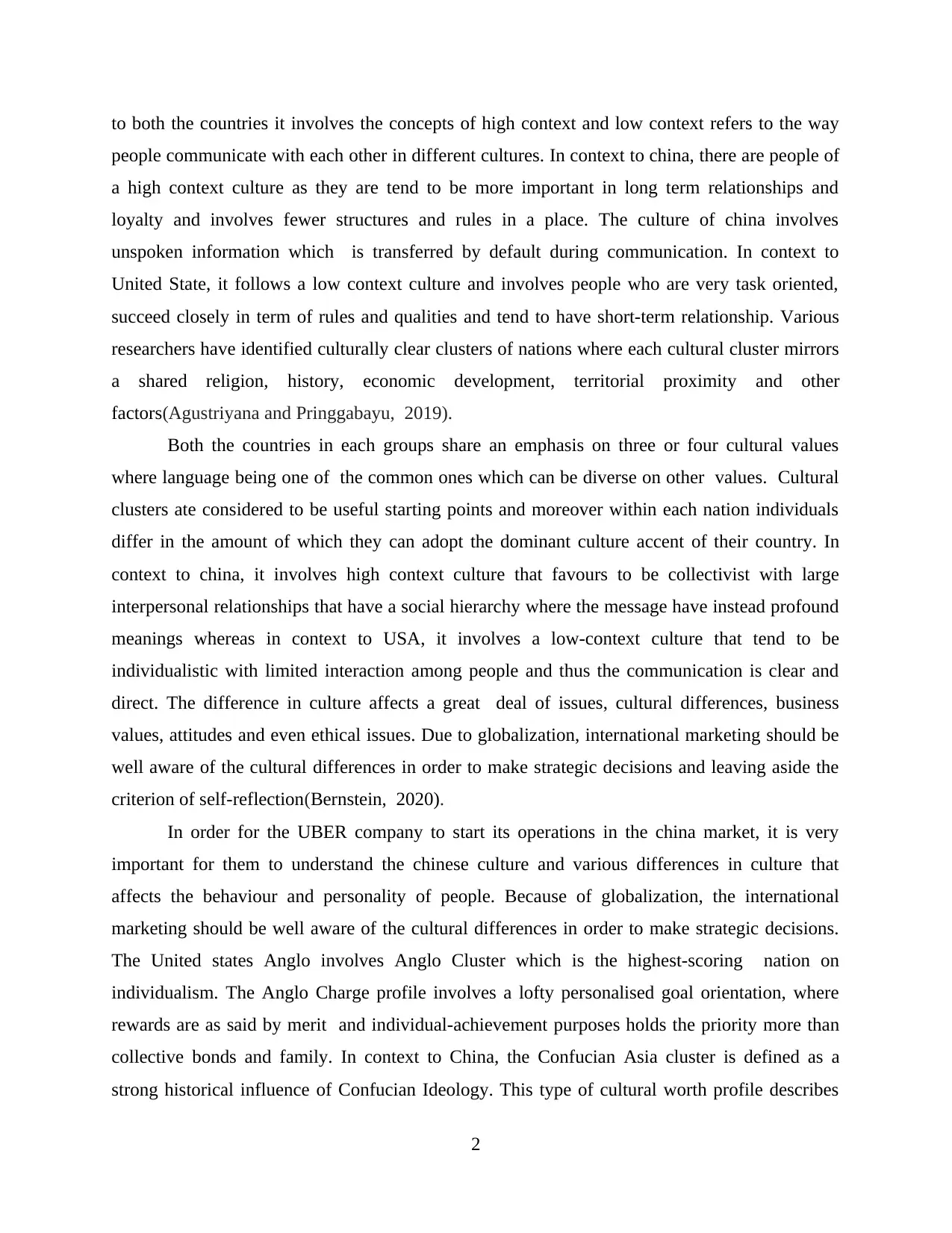
to both the countries it involves the concepts of high context and low context refers to the way
people communicate with each other in different cultures. In context to china, there are people of
a high context culture as they are tend to be more important in long term relationships and
loyalty and involves fewer structures and rules in a place. The culture of china involves
unspoken information which is transferred by default during communication. In context to
United State, it follows a low context culture and involves people who are very task oriented,
succeed closely in term of rules and qualities and tend to have short-term relationship. Various
researchers have identified culturally clear clusters of nations where each cultural cluster mirrors
a shared religion, history, economic development, territorial proximity and other
factors(Agustriyana and Pringgabayu, 2019).
Both the countries in each groups share an emphasis on three or four cultural values
where language being one of the common ones which can be diverse on other values. Cultural
clusters ate considered to be useful starting points and moreover within each nation individuals
differ in the amount of which they can adopt the dominant culture accent of their country. In
context to china, it involves high context culture that favours to be collectivist with large
interpersonal relationships that have a social hierarchy where the message have instead profound
meanings whereas in context to USA, it involves a low-context culture that tend to be
individualistic with limited interaction among people and thus the communication is clear and
direct. The difference in culture affects a great deal of issues, cultural differences, business
values, attitudes and even ethical issues. Due to globalization, international marketing should be
well aware of the cultural differences in order to make strategic decisions and leaving aside the
criterion of self-reflection(Bernstein, 2020).
In order for the UBER company to start its operations in the china market, it is very
important for them to understand the chinese culture and various differences in culture that
affects the behaviour and personality of people. Because of globalization, the international
marketing should be well aware of the cultural differences in order to make strategic decisions.
The United states Anglo involves Anglo Cluster which is the highest-scoring nation on
individualism. The Anglo Charge profile involves a lofty personalised goal orientation, where
rewards are as said by merit and individual-achievement purposes holds the priority more than
collective bonds and family. In context to China, the Confucian Asia cluster is defined as a
strong historical influence of Confucian Ideology. This type of cultural worth profile describes
2
people communicate with each other in different cultures. In context to china, there are people of
a high context culture as they are tend to be more important in long term relationships and
loyalty and involves fewer structures and rules in a place. The culture of china involves
unspoken information which is transferred by default during communication. In context to
United State, it follows a low context culture and involves people who are very task oriented,
succeed closely in term of rules and qualities and tend to have short-term relationship. Various
researchers have identified culturally clear clusters of nations where each cultural cluster mirrors
a shared religion, history, economic development, territorial proximity and other
factors(Agustriyana and Pringgabayu, 2019).
Both the countries in each groups share an emphasis on three or four cultural values
where language being one of the common ones which can be diverse on other values. Cultural
clusters ate considered to be useful starting points and moreover within each nation individuals
differ in the amount of which they can adopt the dominant culture accent of their country. In
context to china, it involves high context culture that favours to be collectivist with large
interpersonal relationships that have a social hierarchy where the message have instead profound
meanings whereas in context to USA, it involves a low-context culture that tend to be
individualistic with limited interaction among people and thus the communication is clear and
direct. The difference in culture affects a great deal of issues, cultural differences, business
values, attitudes and even ethical issues. Due to globalization, international marketing should be
well aware of the cultural differences in order to make strategic decisions and leaving aside the
criterion of self-reflection(Bernstein, 2020).
In order for the UBER company to start its operations in the china market, it is very
important for them to understand the chinese culture and various differences in culture that
affects the behaviour and personality of people. Because of globalization, the international
marketing should be well aware of the cultural differences in order to make strategic decisions.
The United states Anglo involves Anglo Cluster which is the highest-scoring nation on
individualism. The Anglo Charge profile involves a lofty personalised goal orientation, where
rewards are as said by merit and individual-achievement purposes holds the priority more than
collective bonds and family. In context to China, the Confucian Asia cluster is defined as a
strong historical influence of Confucian Ideology. This type of cultural worth profile describes
2
Paraphrase This Document
Need a fresh take? Get an instant paraphrase of this document with our AI Paraphraser
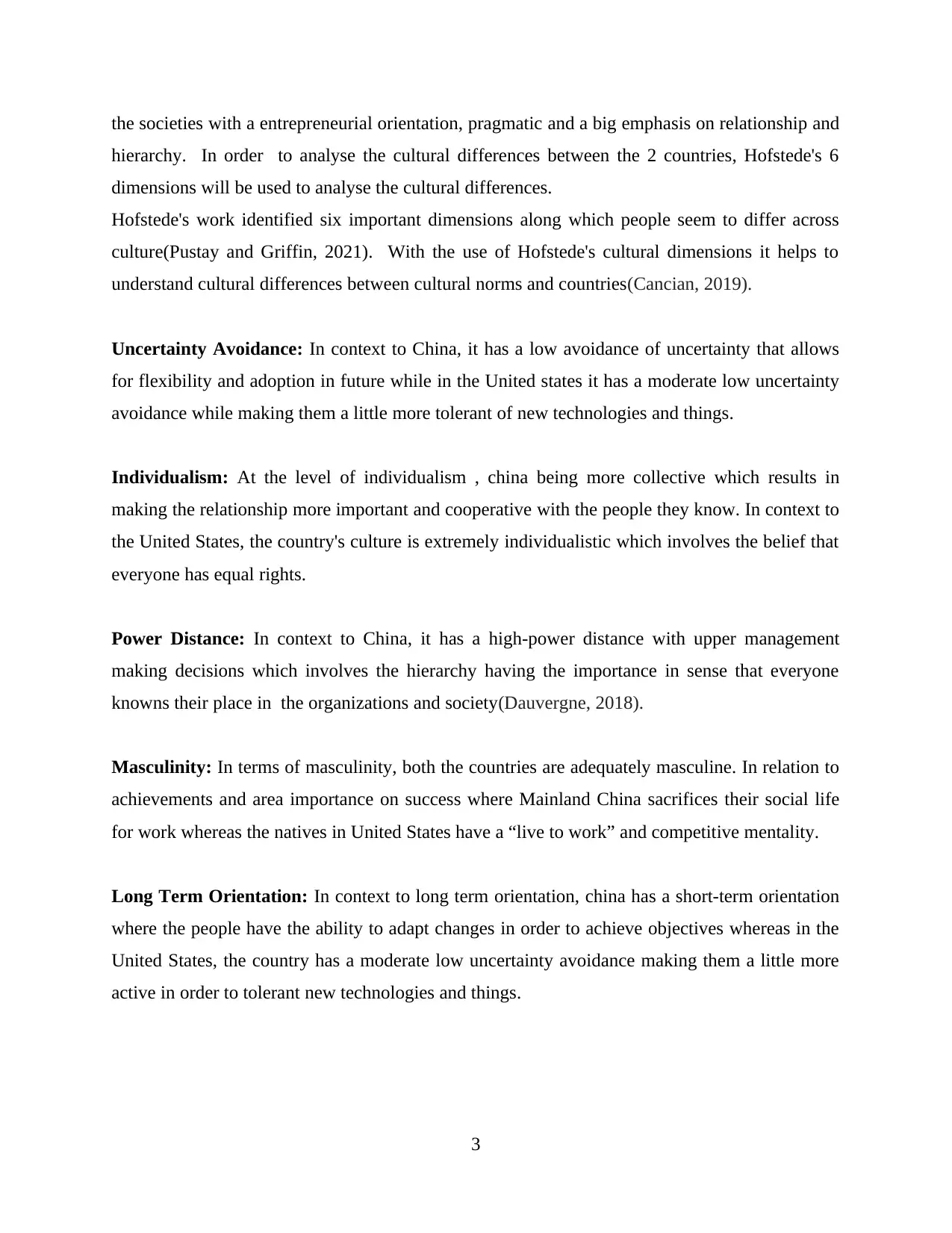
the societies with a entrepreneurial orientation, pragmatic and a big emphasis on relationship and
hierarchy. In order to analyse the cultural differences between the 2 countries, Hofstede's 6
dimensions will be used to analyse the cultural differences.
Hofstede's work identified six important dimensions along which people seem to differ across
culture(Pustay and Griffin, 2021). With the use of Hofstede's cultural dimensions it helps to
understand cultural differences between cultural norms and countries(Cancian, 2019).
Uncertainty Avoidance: In context to China, it has a low avoidance of uncertainty that allows
for flexibility and adoption in future while in the United states it has a moderate low uncertainty
avoidance while making them a little more tolerant of new technologies and things.
Individualism: At the level of individualism , china being more collective which results in
making the relationship more important and cooperative with the people they know. In context to
the United States, the country's culture is extremely individualistic which involves the belief that
everyone has equal rights.
Power Distance: In context to China, it has a high-power distance with upper management
making decisions which involves the hierarchy having the importance in sense that everyone
knowns their place in the organizations and society(Dauvergne, 2018).
Masculinity: In terms of masculinity, both the countries are adequately masculine. In relation to
achievements and area importance on success where Mainland China sacrifices their social life
for work whereas the natives in United States have a “live to work” and competitive mentality.
Long Term Orientation: In context to long term orientation, china has a short-term orientation
where the people have the ability to adapt changes in order to achieve objectives whereas in the
United States, the country has a moderate low uncertainty avoidance making them a little more
active in order to tolerant new technologies and things.
3
hierarchy. In order to analyse the cultural differences between the 2 countries, Hofstede's 6
dimensions will be used to analyse the cultural differences.
Hofstede's work identified six important dimensions along which people seem to differ across
culture(Pustay and Griffin, 2021). With the use of Hofstede's cultural dimensions it helps to
understand cultural differences between cultural norms and countries(Cancian, 2019).
Uncertainty Avoidance: In context to China, it has a low avoidance of uncertainty that allows
for flexibility and adoption in future while in the United states it has a moderate low uncertainty
avoidance while making them a little more tolerant of new technologies and things.
Individualism: At the level of individualism , china being more collective which results in
making the relationship more important and cooperative with the people they know. In context to
the United States, the country's culture is extremely individualistic which involves the belief that
everyone has equal rights.
Power Distance: In context to China, it has a high-power distance with upper management
making decisions which involves the hierarchy having the importance in sense that everyone
knowns their place in the organizations and society(Dauvergne, 2018).
Masculinity: In terms of masculinity, both the countries are adequately masculine. In relation to
achievements and area importance on success where Mainland China sacrifices their social life
for work whereas the natives in United States have a “live to work” and competitive mentality.
Long Term Orientation: In context to long term orientation, china has a short-term orientation
where the people have the ability to adapt changes in order to achieve objectives whereas in the
United States, the country has a moderate low uncertainty avoidance making them a little more
active in order to tolerant new technologies and things.
3
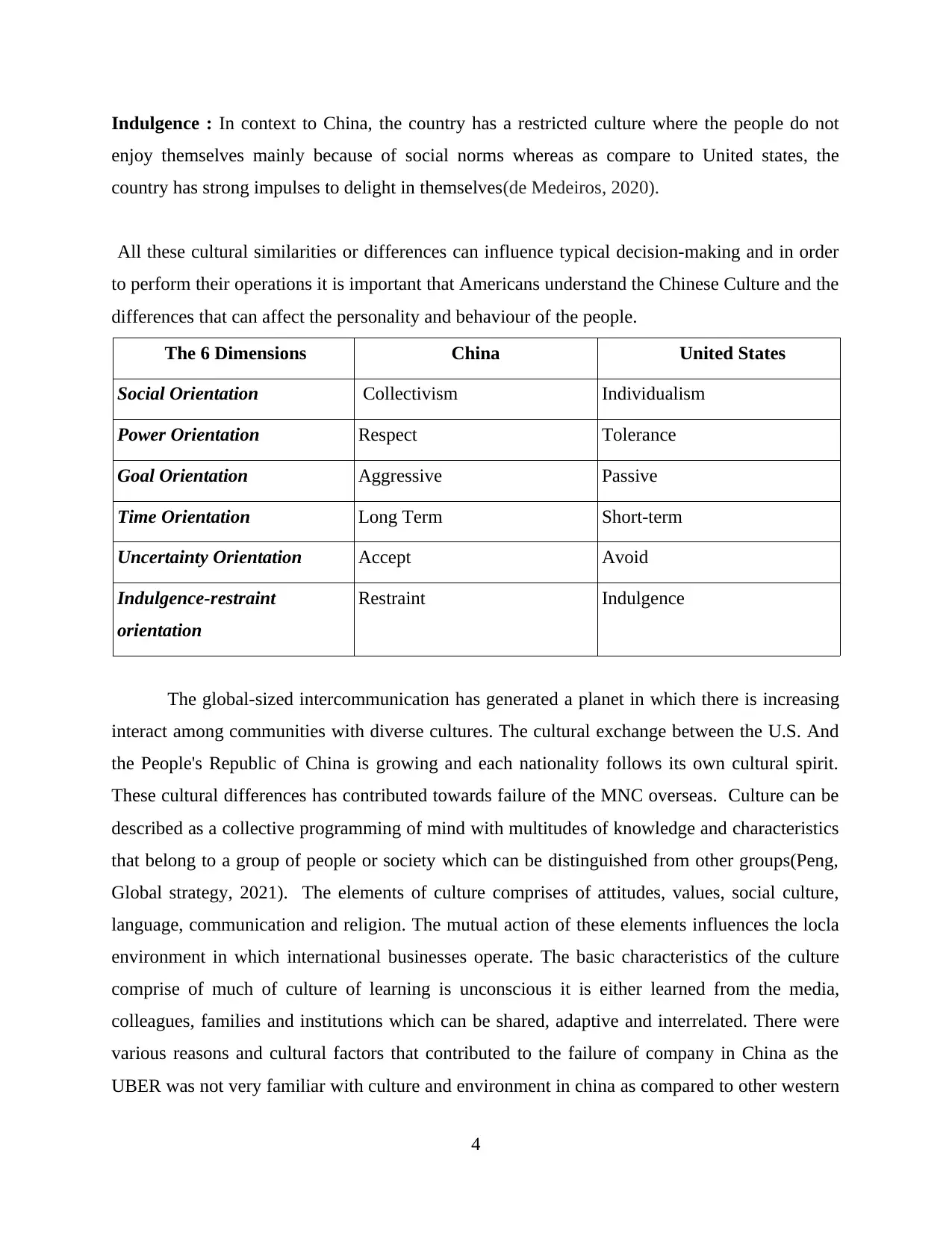
Indulgence : In context to China, the country has a restricted culture where the people do not
enjoy themselves mainly because of social norms whereas as compare to United states, the
country has strong impulses to delight in themselves(de Medeiros, 2020).
All these cultural similarities or differences can influence typical decision-making and in order
to perform their operations it is important that Americans understand the Chinese Culture and the
differences that can affect the personality and behaviour of the people.
The 6 Dimensions China United States
Social Orientation Collectivism Individualism
Power Orientation Respect Tolerance
Goal Orientation Aggressive Passive
Time Orientation Long Term Short-term
Uncertainty Orientation Accept Avoid
Indulgence-restraint
orientation
Restraint Indulgence
The global-sized intercommunication has generated a planet in which there is increasing
interact among communities with diverse cultures. The cultural exchange between the U.S. And
the People's Republic of China is growing and each nationality follows its own cultural spirit.
These cultural differences has contributed towards failure of the MNC overseas. Culture can be
described as a collective programming of mind with multitudes of knowledge and characteristics
that belong to a group of people or society which can be distinguished from other groups(Peng,
Global strategy, 2021). The elements of culture comprises of attitudes, values, social culture,
language, communication and religion. The mutual action of these elements influences the locla
environment in which international businesses operate. The basic characteristics of the culture
comprise of much of culture of learning is unconscious it is either learned from the media,
colleagues, families and institutions which can be shared, adaptive and interrelated. There were
various reasons and cultural factors that contributed to the failure of company in China as the
UBER was not very familiar with culture and environment in china as compared to other western
4
enjoy themselves mainly because of social norms whereas as compare to United states, the
country has strong impulses to delight in themselves(de Medeiros, 2020).
All these cultural similarities or differences can influence typical decision-making and in order
to perform their operations it is important that Americans understand the Chinese Culture and the
differences that can affect the personality and behaviour of the people.
The 6 Dimensions China United States
Social Orientation Collectivism Individualism
Power Orientation Respect Tolerance
Goal Orientation Aggressive Passive
Time Orientation Long Term Short-term
Uncertainty Orientation Accept Avoid
Indulgence-restraint
orientation
Restraint Indulgence
The global-sized intercommunication has generated a planet in which there is increasing
interact among communities with diverse cultures. The cultural exchange between the U.S. And
the People's Republic of China is growing and each nationality follows its own cultural spirit.
These cultural differences has contributed towards failure of the MNC overseas. Culture can be
described as a collective programming of mind with multitudes of knowledge and characteristics
that belong to a group of people or society which can be distinguished from other groups(Peng,
Global strategy, 2021). The elements of culture comprises of attitudes, values, social culture,
language, communication and religion. The mutual action of these elements influences the locla
environment in which international businesses operate. The basic characteristics of the culture
comprise of much of culture of learning is unconscious it is either learned from the media,
colleagues, families and institutions which can be shared, adaptive and interrelated. There were
various reasons and cultural factors that contributed to the failure of company in China as the
UBER was not very familiar with culture and environment in china as compared to other western
4
⊘ This is a preview!⊘
Do you want full access?
Subscribe today to unlock all pages.

Trusted by 1+ million students worldwide
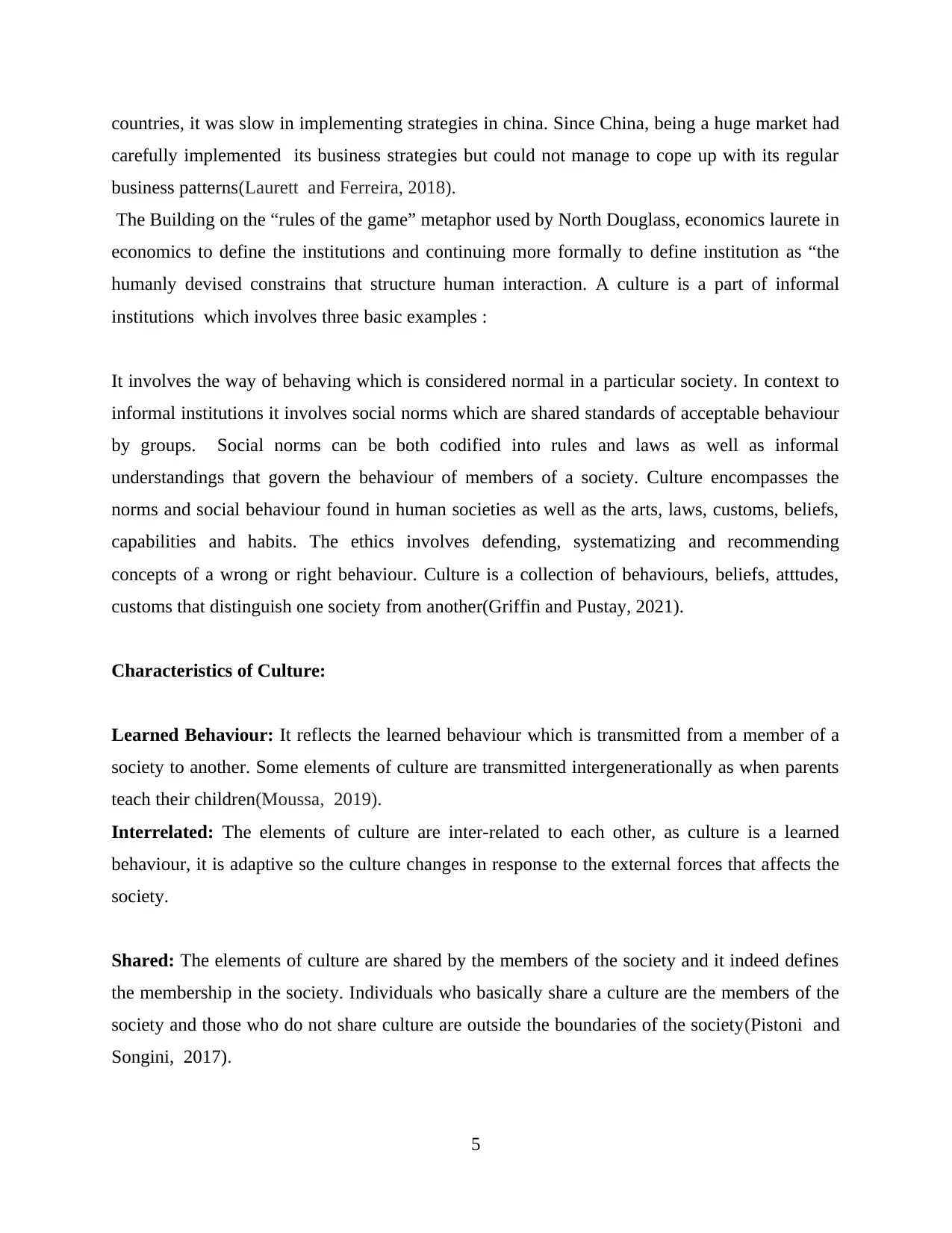
countries, it was slow in implementing strategies in china. Since China, being a huge market had
carefully implemented its business strategies but could not manage to cope up with its regular
business patterns(Laurett and Ferreira, 2018).
The Building on the “rules of the game” metaphor used by North Douglass, economics laurete in
economics to define the institutions and continuing more formally to define institution as “the
humanly devised constrains that structure human interaction. A culture is a part of informal
institutions which involves three basic examples :
It involves the way of behaving which is considered normal in a particular society. In context to
informal institutions it involves social norms which are shared standards of acceptable behaviour
by groups. Social norms can be both codified into rules and laws as well as informal
understandings that govern the behaviour of members of a society. Culture encompasses the
norms and social behaviour found in human societies as well as the arts, laws, customs, beliefs,
capabilities and habits. The ethics involves defending, systematizing and recommending
concepts of a wrong or right behaviour. Culture is a collection of behaviours, beliefs, atttudes,
customs that distinguish one society from another(Griffin and Pustay, 2021).
Characteristics of Culture:
Learned Behaviour: It reflects the learned behaviour which is transmitted from a member of a
society to another. Some elements of culture are transmitted intergenerationally as when parents
teach their children(Moussa, 2019).
Interrelated: The elements of culture are inter-related to each other, as culture is a learned
behaviour, it is adaptive so the culture changes in response to the external forces that affects the
society.
Shared: The elements of culture are shared by the members of the society and it indeed defines
the membership in the society. Individuals who basically share a culture are the members of the
society and those who do not share culture are outside the boundaries of the society(Pistoni and
Songini, 2017).
5
carefully implemented its business strategies but could not manage to cope up with its regular
business patterns(Laurett and Ferreira, 2018).
The Building on the “rules of the game” metaphor used by North Douglass, economics laurete in
economics to define the institutions and continuing more formally to define institution as “the
humanly devised constrains that structure human interaction. A culture is a part of informal
institutions which involves three basic examples :
It involves the way of behaving which is considered normal in a particular society. In context to
informal institutions it involves social norms which are shared standards of acceptable behaviour
by groups. Social norms can be both codified into rules and laws as well as informal
understandings that govern the behaviour of members of a society. Culture encompasses the
norms and social behaviour found in human societies as well as the arts, laws, customs, beliefs,
capabilities and habits. The ethics involves defending, systematizing and recommending
concepts of a wrong or right behaviour. Culture is a collection of behaviours, beliefs, atttudes,
customs that distinguish one society from another(Griffin and Pustay, 2021).
Characteristics of Culture:
Learned Behaviour: It reflects the learned behaviour which is transmitted from a member of a
society to another. Some elements of culture are transmitted intergenerationally as when parents
teach their children(Moussa, 2019).
Interrelated: The elements of culture are inter-related to each other, as culture is a learned
behaviour, it is adaptive so the culture changes in response to the external forces that affects the
society.
Shared: The elements of culture are shared by the members of the society and it indeed defines
the membership in the society. Individuals who basically share a culture are the members of the
society and those who do not share culture are outside the boundaries of the society(Pistoni and
Songini, 2017).
5
Paraphrase This Document
Need a fresh take? Get an instant paraphrase of this document with our AI Paraphraser
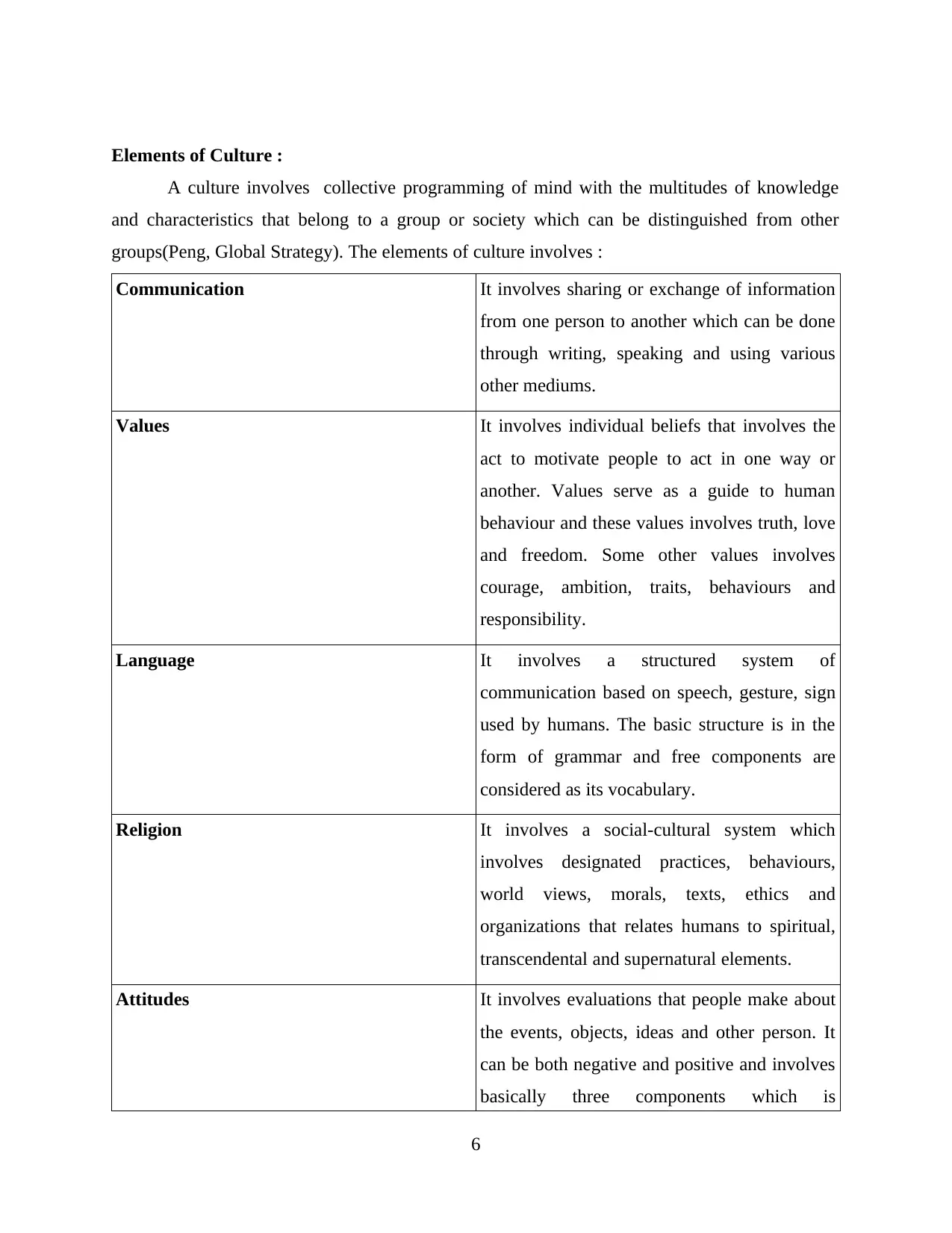
Elements of Culture :
A culture involves collective programming of mind with the multitudes of knowledge
and characteristics that belong to a group or society which can be distinguished from other
groups(Peng, Global Strategy). The elements of culture involves :
Communication It involves sharing or exchange of information
from one person to another which can be done
through writing, speaking and using various
other mediums.
Values It involves individual beliefs that involves the
act to motivate people to act in one way or
another. Values serve as a guide to human
behaviour and these values involves truth, love
and freedom. Some other values involves
courage, ambition, traits, behaviours and
responsibility.
Language It involves a structured system of
communication based on speech, gesture, sign
used by humans. The basic structure is in the
form of grammar and free components are
considered as its vocabulary.
Religion It involves a social-cultural system which
involves designated practices, behaviours,
world views, morals, texts, ethics and
organizations that relates humans to spiritual,
transcendental and supernatural elements.
Attitudes It involves evaluations that people make about
the events, objects, ideas and other person. It
can be both negative and positive and involves
basically three components which is
6
A culture involves collective programming of mind with the multitudes of knowledge
and characteristics that belong to a group or society which can be distinguished from other
groups(Peng, Global Strategy). The elements of culture involves :
Communication It involves sharing or exchange of information
from one person to another which can be done
through writing, speaking and using various
other mediums.
Values It involves individual beliefs that involves the
act to motivate people to act in one way or
another. Values serve as a guide to human
behaviour and these values involves truth, love
and freedom. Some other values involves
courage, ambition, traits, behaviours and
responsibility.
Language It involves a structured system of
communication based on speech, gesture, sign
used by humans. The basic structure is in the
form of grammar and free components are
considered as its vocabulary.
Religion It involves a social-cultural system which
involves designated practices, behaviours,
world views, morals, texts, ethics and
organizations that relates humans to spiritual,
transcendental and supernatural elements.
Attitudes It involves evaluations that people make about
the events, objects, ideas and other person. It
can be both negative and positive and involves
basically three components which is
6
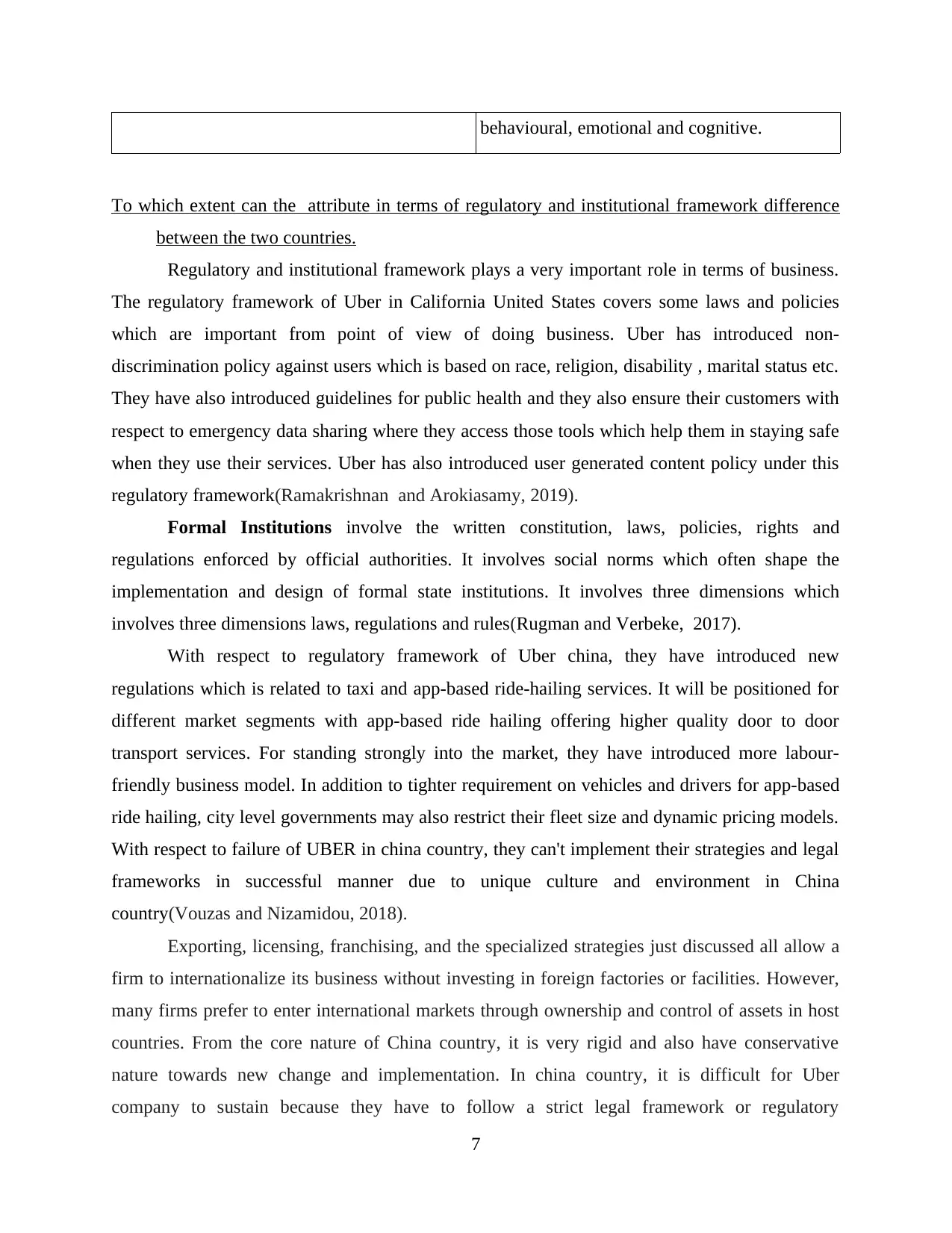
behavioural, emotional and cognitive.
To which extent can the attribute in terms of regulatory and institutional framework difference
between the two countries.
Regulatory and institutional framework plays a very important role in terms of business.
The regulatory framework of Uber in California United States covers some laws and policies
which are important from point of view of doing business. Uber has introduced non-
discrimination policy against users which is based on race, religion, disability , marital status etc.
They have also introduced guidelines for public health and they also ensure their customers with
respect to emergency data sharing where they access those tools which help them in staying safe
when they use their services. Uber has also introduced user generated content policy under this
regulatory framework(Ramakrishnan and Arokiasamy, 2019).
Formal Institutions involve the written constitution, laws, policies, rights and
regulations enforced by official authorities. It involves social norms which often shape the
implementation and design of formal state institutions. It involves three dimensions which
involves three dimensions laws, regulations and rules(Rugman and Verbeke, 2017).
With respect to regulatory framework of Uber china, they have introduced new
regulations which is related to taxi and app-based ride-hailing services. It will be positioned for
different market segments with app-based ride hailing offering higher quality door to door
transport services. For standing strongly into the market, they have introduced more labour-
friendly business model. In addition to tighter requirement on vehicles and drivers for app-based
ride hailing, city level governments may also restrict their fleet size and dynamic pricing models.
With respect to failure of UBER in china country, they can't implement their strategies and legal
frameworks in successful manner due to unique culture and environment in China
country(Vouzas and Nizamidou, 2018).
Exporting, licensing, franchising, and the specialized strategies just discussed all allow a
firm to internationalize its business without investing in foreign factories or facilities. However,
many firms prefer to enter international markets through ownership and control of assets in host
countries. From the core nature of China country, it is very rigid and also have conservative
nature towards new change and implementation. In china country, it is difficult for Uber
company to sustain because they have to follow a strict legal framework or regulatory
7
To which extent can the attribute in terms of regulatory and institutional framework difference
between the two countries.
Regulatory and institutional framework plays a very important role in terms of business.
The regulatory framework of Uber in California United States covers some laws and policies
which are important from point of view of doing business. Uber has introduced non-
discrimination policy against users which is based on race, religion, disability , marital status etc.
They have also introduced guidelines for public health and they also ensure their customers with
respect to emergency data sharing where they access those tools which help them in staying safe
when they use their services. Uber has also introduced user generated content policy under this
regulatory framework(Ramakrishnan and Arokiasamy, 2019).
Formal Institutions involve the written constitution, laws, policies, rights and
regulations enforced by official authorities. It involves social norms which often shape the
implementation and design of formal state institutions. It involves three dimensions which
involves three dimensions laws, regulations and rules(Rugman and Verbeke, 2017).
With respect to regulatory framework of Uber china, they have introduced new
regulations which is related to taxi and app-based ride-hailing services. It will be positioned for
different market segments with app-based ride hailing offering higher quality door to door
transport services. For standing strongly into the market, they have introduced more labour-
friendly business model. In addition to tighter requirement on vehicles and drivers for app-based
ride hailing, city level governments may also restrict their fleet size and dynamic pricing models.
With respect to failure of UBER in china country, they can't implement their strategies and legal
frameworks in successful manner due to unique culture and environment in China
country(Vouzas and Nizamidou, 2018).
Exporting, licensing, franchising, and the specialized strategies just discussed all allow a
firm to internationalize its business without investing in foreign factories or facilities. However,
many firms prefer to enter international markets through ownership and control of assets in host
countries. From the core nature of China country, it is very rigid and also have conservative
nature towards new change and implementation. In china country, it is difficult for Uber
company to sustain because they have to follow a strict legal framework or regulatory
7
⊘ This is a preview!⊘
Do you want full access?
Subscribe today to unlock all pages.

Trusted by 1+ million students worldwide
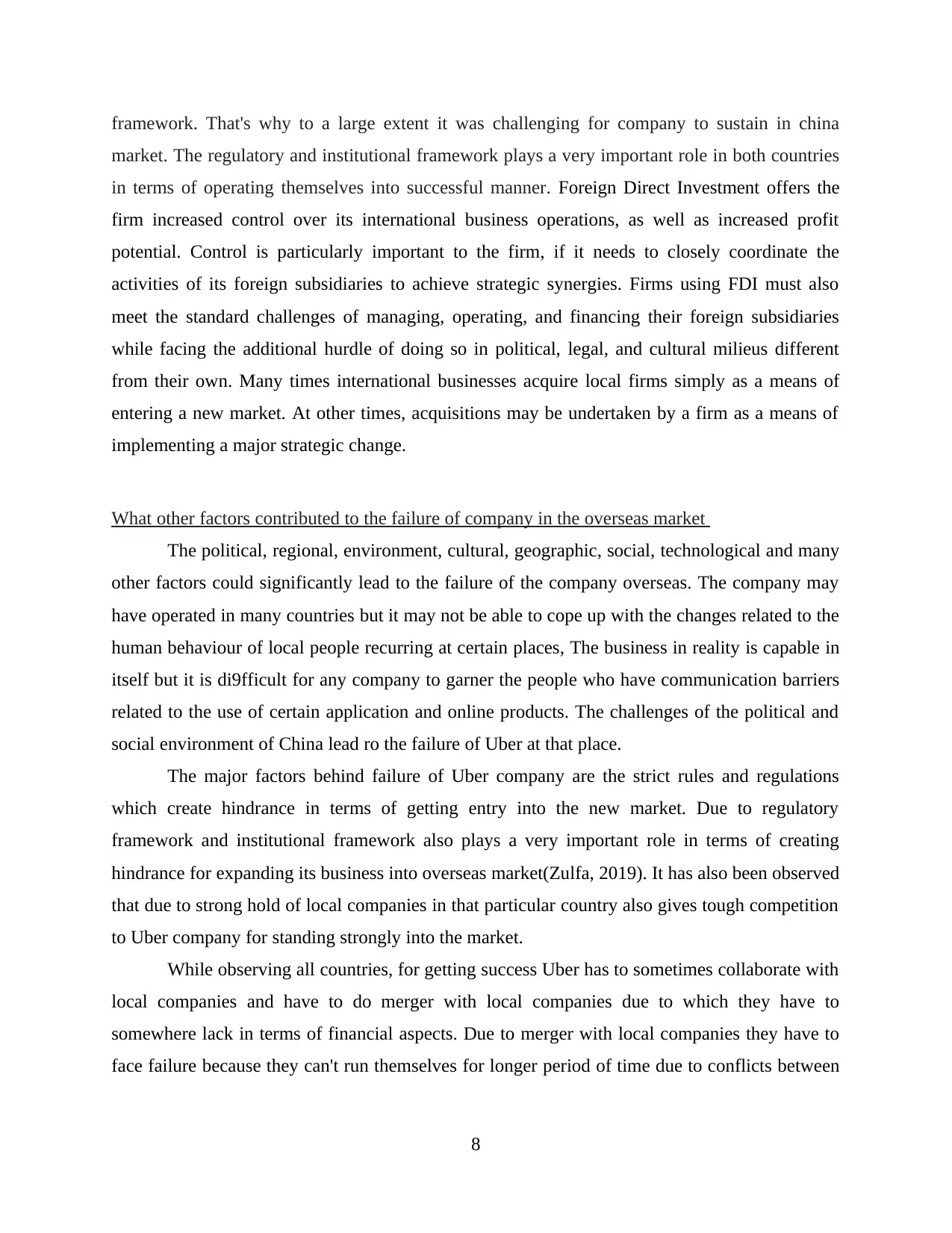
framework. That's why to a large extent it was challenging for company to sustain in china
market. The regulatory and institutional framework plays a very important role in both countries
in terms of operating themselves into successful manner. Foreign Direct Investment offers the
firm increased control over its international business operations, as well as increased profit
potential. Control is particularly important to the firm, if it needs to closely coordinate the
activities of its foreign subsidiaries to achieve strategic synergies. Firms using FDI must also
meet the standard challenges of managing, operating, and financing their foreign subsidiaries
while facing the additional hurdle of doing so in political, legal, and cultural milieus different
from their own. Many times international businesses acquire local firms simply as a means of
entering a new market. At other times, acquisitions may be undertaken by a firm as a means of
implementing a major strategic change.
What other factors contributed to the failure of company in the overseas market
The political, regional, environment, cultural, geographic, social, technological and many
other factors could significantly lead to the failure of the company overseas. The company may
have operated in many countries but it may not be able to cope up with the changes related to the
human behaviour of local people recurring at certain places, The business in reality is capable in
itself but it is di9fficult for any company to garner the people who have communication barriers
related to the use of certain application and online products. The challenges of the political and
social environment of China lead ro the failure of Uber at that place.
The major factors behind failure of Uber company are the strict rules and regulations
which create hindrance in terms of getting entry into the new market. Due to regulatory
framework and institutional framework also plays a very important role in terms of creating
hindrance for expanding its business into overseas market(Zulfa, 2019). It has also been observed
that due to strong hold of local companies in that particular country also gives tough competition
to Uber company for standing strongly into the market.
While observing all countries, for getting success Uber has to sometimes collaborate with
local companies and have to do merger with local companies due to which they have to
somewhere lack in terms of financial aspects. Due to merger with local companies they have to
face failure because they can't run themselves for longer period of time due to conflicts between
8
market. The regulatory and institutional framework plays a very important role in both countries
in terms of operating themselves into successful manner. Foreign Direct Investment offers the
firm increased control over its international business operations, as well as increased profit
potential. Control is particularly important to the firm, if it needs to closely coordinate the
activities of its foreign subsidiaries to achieve strategic synergies. Firms using FDI must also
meet the standard challenges of managing, operating, and financing their foreign subsidiaries
while facing the additional hurdle of doing so in political, legal, and cultural milieus different
from their own. Many times international businesses acquire local firms simply as a means of
entering a new market. At other times, acquisitions may be undertaken by a firm as a means of
implementing a major strategic change.
What other factors contributed to the failure of company in the overseas market
The political, regional, environment, cultural, geographic, social, technological and many
other factors could significantly lead to the failure of the company overseas. The company may
have operated in many countries but it may not be able to cope up with the changes related to the
human behaviour of local people recurring at certain places, The business in reality is capable in
itself but it is di9fficult for any company to garner the people who have communication barriers
related to the use of certain application and online products. The challenges of the political and
social environment of China lead ro the failure of Uber at that place.
The major factors behind failure of Uber company are the strict rules and regulations
which create hindrance in terms of getting entry into the new market. Due to regulatory
framework and institutional framework also plays a very important role in terms of creating
hindrance for expanding its business into overseas market(Zulfa, 2019). It has also been observed
that due to strong hold of local companies in that particular country also gives tough competition
to Uber company for standing strongly into the market.
While observing all countries, for getting success Uber has to sometimes collaborate with
local companies and have to do merger with local companies due to which they have to
somewhere lack in terms of financial aspects. Due to merger with local companies they have to
face failure because they can't run themselves for longer period of time due to conflicts between
8
Paraphrase This Document
Need a fresh take? Get an instant paraphrase of this document with our AI Paraphraser
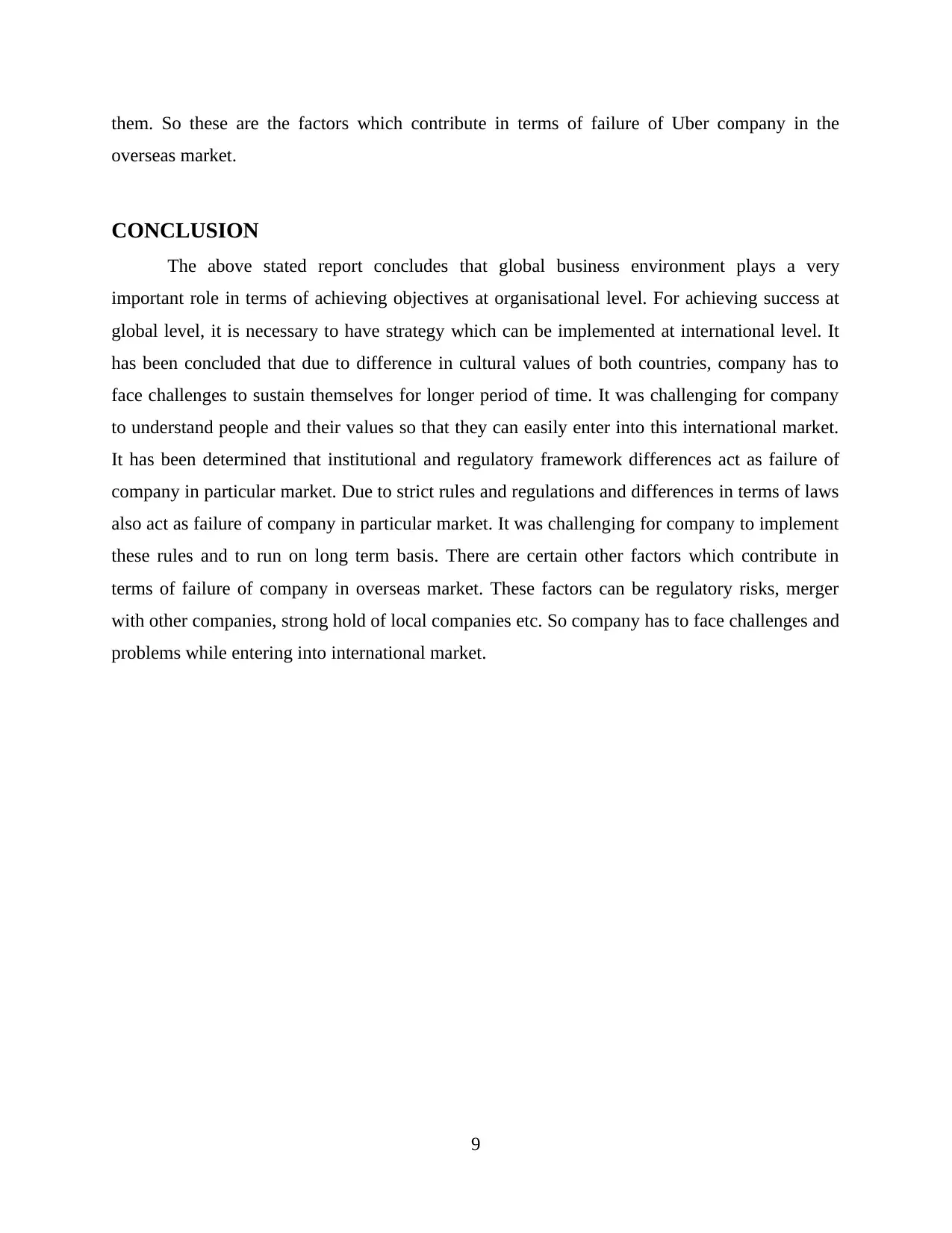
them. So these are the factors which contribute in terms of failure of Uber company in the
overseas market.
CONCLUSION
The above stated report concludes that global business environment plays a very
important role in terms of achieving objectives at organisational level. For achieving success at
global level, it is necessary to have strategy which can be implemented at international level. It
has been concluded that due to difference in cultural values of both countries, company has to
face challenges to sustain themselves for longer period of time. It was challenging for company
to understand people and their values so that they can easily enter into this international market.
It has been determined that institutional and regulatory framework differences act as failure of
company in particular market. Due to strict rules and regulations and differences in terms of laws
also act as failure of company in particular market. It was challenging for company to implement
these rules and to run on long term basis. There are certain other factors which contribute in
terms of failure of company in overseas market. These factors can be regulatory risks, merger
with other companies, strong hold of local companies etc. So company has to face challenges and
problems while entering into international market.
9
overseas market.
CONCLUSION
The above stated report concludes that global business environment plays a very
important role in terms of achieving objectives at organisational level. For achieving success at
global level, it is necessary to have strategy which can be implemented at international level. It
has been concluded that due to difference in cultural values of both countries, company has to
face challenges to sustain themselves for longer period of time. It was challenging for company
to understand people and their values so that they can easily enter into this international market.
It has been determined that institutional and regulatory framework differences act as failure of
company in particular market. Due to strict rules and regulations and differences in terms of laws
also act as failure of company in particular market. It was challenging for company to implement
these rules and to run on long term basis. There are certain other factors which contribute in
terms of failure of company in overseas market. These factors can be regulatory risks, merger
with other companies, strong hold of local companies etc. So company has to face challenges and
problems while entering into international market.
9
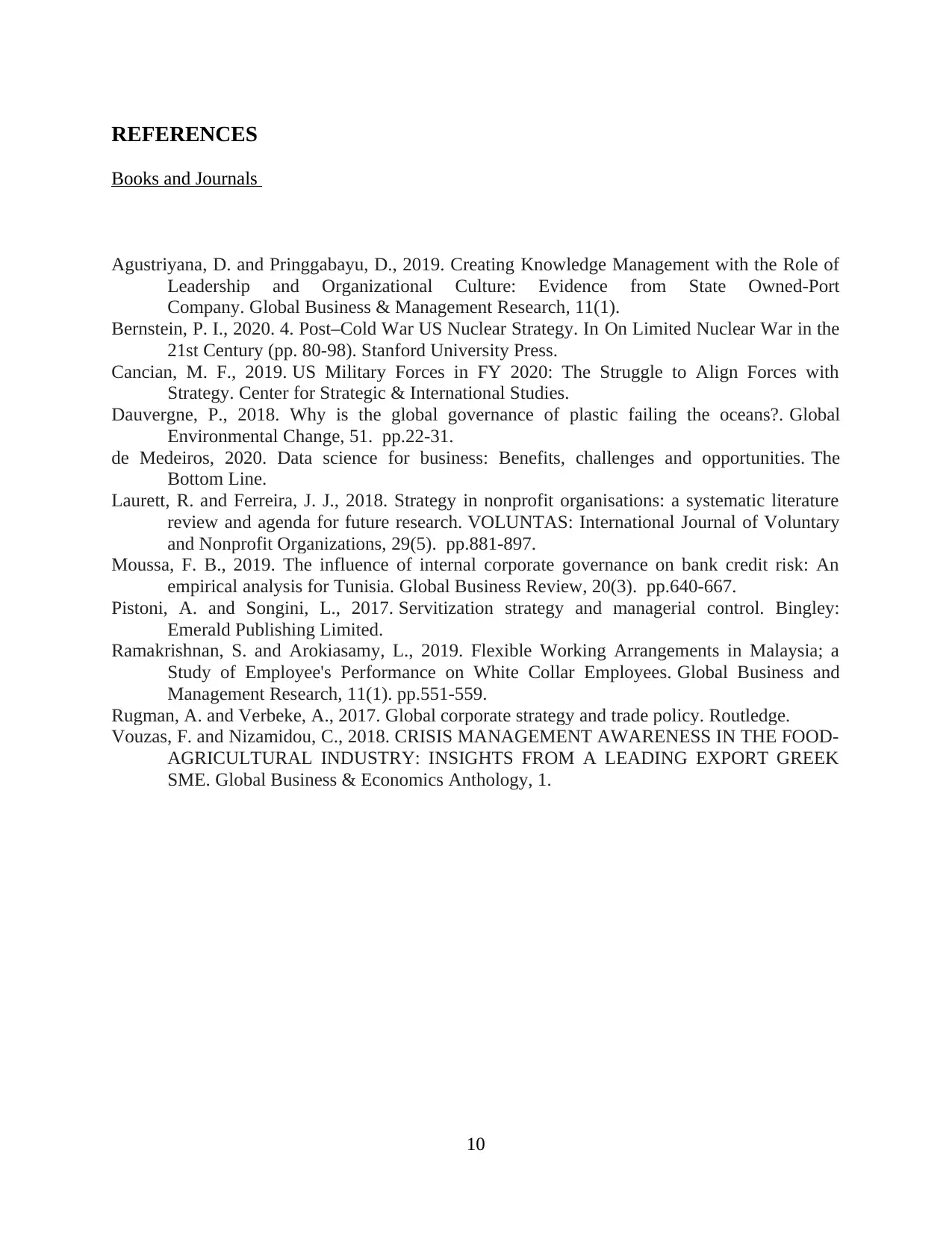
REFERENCES
Books and Journals
Agustriyana, D. and Pringgabayu, D., 2019. Creating Knowledge Management with the Role of
Leadership and Organizational Culture: Evidence from State Owned-Port
Company. Global Business & Management Research, 11(1).
Bernstein, P. I., 2020. 4. Post–Cold War US Nuclear Strategy. In On Limited Nuclear War in the
21st Century (pp. 80-98). Stanford University Press.
Cancian, M. F., 2019. US Military Forces in FY 2020: The Struggle to Align Forces with
Strategy. Center for Strategic & International Studies.
Dauvergne, P., 2018. Why is the global governance of plastic failing the oceans?. Global
Environmental Change, 51. pp.22-31.
de Medeiros, 2020. Data science for business: Benefits, challenges and opportunities. The
Bottom Line.
Laurett, R. and Ferreira, J. J., 2018. Strategy in nonprofit organisations: a systematic literature
review and agenda for future research. VOLUNTAS: International Journal of Voluntary
and Nonprofit Organizations, 29(5). pp.881-897.
Moussa, F. B., 2019. The influence of internal corporate governance on bank credit risk: An
empirical analysis for Tunisia. Global Business Review, 20(3). pp.640-667.
Pistoni, A. and Songini, L., 2017. Servitization strategy and managerial control. Bingley:
Emerald Publishing Limited.
Ramakrishnan, S. and Arokiasamy, L., 2019. Flexible Working Arrangements in Malaysia; a
Study of Employee's Performance on White Collar Employees. Global Business and
Management Research, 11(1). pp.551-559.
Rugman, A. and Verbeke, A., 2017. Global corporate strategy and trade policy. Routledge.
Vouzas, F. and Nizamidou, C., 2018. CRISIS MANAGEMENT AWARENESS IN THE FOOD-
AGRICULTURAL INDUSTRY: INSIGHTS FROM A LEADING EXPORT GREEK
SME. Global Business & Economics Anthology, 1.
10
Books and Journals
Agustriyana, D. and Pringgabayu, D., 2019. Creating Knowledge Management with the Role of
Leadership and Organizational Culture: Evidence from State Owned-Port
Company. Global Business & Management Research, 11(1).
Bernstein, P. I., 2020. 4. Post–Cold War US Nuclear Strategy. In On Limited Nuclear War in the
21st Century (pp. 80-98). Stanford University Press.
Cancian, M. F., 2019. US Military Forces in FY 2020: The Struggle to Align Forces with
Strategy. Center for Strategic & International Studies.
Dauvergne, P., 2018. Why is the global governance of plastic failing the oceans?. Global
Environmental Change, 51. pp.22-31.
de Medeiros, 2020. Data science for business: Benefits, challenges and opportunities. The
Bottom Line.
Laurett, R. and Ferreira, J. J., 2018. Strategy in nonprofit organisations: a systematic literature
review and agenda for future research. VOLUNTAS: International Journal of Voluntary
and Nonprofit Organizations, 29(5). pp.881-897.
Moussa, F. B., 2019. The influence of internal corporate governance on bank credit risk: An
empirical analysis for Tunisia. Global Business Review, 20(3). pp.640-667.
Pistoni, A. and Songini, L., 2017. Servitization strategy and managerial control. Bingley:
Emerald Publishing Limited.
Ramakrishnan, S. and Arokiasamy, L., 2019. Flexible Working Arrangements in Malaysia; a
Study of Employee's Performance on White Collar Employees. Global Business and
Management Research, 11(1). pp.551-559.
Rugman, A. and Verbeke, A., 2017. Global corporate strategy and trade policy. Routledge.
Vouzas, F. and Nizamidou, C., 2018. CRISIS MANAGEMENT AWARENESS IN THE FOOD-
AGRICULTURAL INDUSTRY: INSIGHTS FROM A LEADING EXPORT GREEK
SME. Global Business & Economics Anthology, 1.
10
⊘ This is a preview!⊘
Do you want full access?
Subscribe today to unlock all pages.

Trusted by 1+ million students worldwide
1 out of 13
Related Documents
Your All-in-One AI-Powered Toolkit for Academic Success.
+13062052269
info@desklib.com
Available 24*7 on WhatsApp / Email
![[object Object]](/_next/static/media/star-bottom.7253800d.svg)
Unlock your academic potential
Copyright © 2020–2025 A2Z Services. All Rights Reserved. Developed and managed by ZUCOL.





